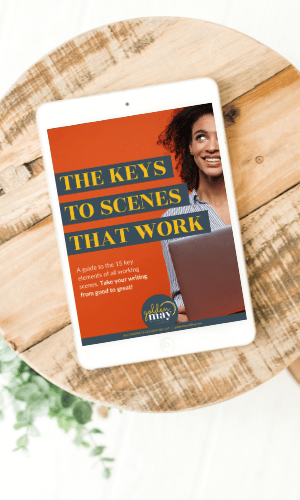As readers, we’re engaged in a story’s plot because we know what the main character wants and why—and we’re dying to find out how far they’ll go to get it. We’re not engaged in the plot itself, but rather how it affects and influences the characters we’ve come to love. This means we must plan, plot, and write our stories with our characters front of mind.
What is a character arc?
Stories are about change. Specifically, they’re about how your main character changes as a result of the story’s plot events. They open the story as one person, with a specific view of the world, and by Act 3 they’ve transformed into someone new, with a new understanding of the world and their role in it.
Your main character opens the story with an Internal Obstacle belief. At the beginning of the story they operate with a specific (usually problematic) worldview, belief system, and/or perspective—one that’s grown out of their past experiences, shaped their life, and made them who they are when the story opens. We call this their Internal Obstacle.
EXAMPLE #1: In A Game of Thrones, Jon Snow opens the story with the belief that “You gain honor by gaining power and glory.”
EXAMPLE #2: In The Hunger Games, Katniss Everdeen opens the story with a fierce belief that “Survival, of self and family, is the only reasonable goal.”
Your main character closes with the Story Point as their new outlook. By the end of the story (if it’s a positive arc of change), your character’s internal obstacle will have led them so far astray that they finally question it, shed it, and adopt the story’s point in its place. A story point is a single, concise statement that your main character will come to believe and/or prove in Act 3. It’s the message or thematic statement of your story.
EXAMPLE #1: Jon Snow ends A Game of Thrones by accepting and proving the story point that “There is no room for honor in the game for power.”
EXAMPLE #2: Katniss Everdeen ends The Hunger Games with the understanding that “There are goals more worthy and important than simply surviving.”
Your character’s path from Internal Obstacle → Story Point is their character arc. In cohesive stories, the two concepts are inextricably tied. Your character cannot believe, learn, or act in accordance with your story point until they’ve unlearned their internal obstacle.
EXAMPLE #1: Jon Snow must come to terms with the fact that honor is not determined by power or glory (ie. unlearn his internal obstacle) and set aside his quest for glory in order to gain the honor he seeks (ie. he must learn the story point).
EXAMPLE #2: Katniss Everdeen can’t learn that there are goals more worthy and important than simply surviving unless she lets go of her internal obstacle belief that surviving and protecting her family are her sole goals in life.
How does plot fit in?
As humans, we don’t change easily. We’re unlikely to shift our worldview because someone tells us to. We generally change as a result of the consequences of our actions. When we mess up, and lose people we loved or things we wanted in the process, then we start to see things differently. Then we start to note the errors of our ways. Therefore, your plot’s events should be specifically designed to confront your main character with their internal obstacle again and again. As they continually make bad choices because of their internal obstacle, they’ll set in motion negative consequences that will pile up until they can’t ignore them anymore and have to change.
#1—Your plot’s biggest challenges must appear as barriers to your character because of their internal obstacle. Your character’s internal obstacle is the lens through which they see the world and deem what’s important and what’s not. As a result, the antagonistic force they’re fighting throughout the story must appear as an antagonist because they’re viewing it through their internal obstacle.
EXAMPLE #1: In A Game of Thrones, Jon Snow seeks to prove he’s an honorable man. Because of his internal obstacle belief that glory and power will bring him honor, he views the Night’s Watch hierarchy as his primary plot obstacle. He wants to climb the ranks, prove he’s an apt warrior by achieving glory, and therefore gain honor among the Night’s Watch men.
EXAMPLE #2: In The Hunger Games, Katniss Everdeen wants to survive so she can ensure her family survives. Because of her internal obstacle belief that survival is the only reasonable goal, she sees the Hunger Games—rather than the government—as her primary plot obstacle. She believes her focus must be to win.
#2—As your character fights against the plot’s biggest challenges, those challenges should be designed to teach them the story point. The strongest plot challenges are designed to subtly prove the story’s point even as the character is fighting against the belief. Your character should get shoved into situations that are destined to teach them the truth, whether they’re ready for it or not.
EXAMPLE #1: In A Game of Thrones, Jon is climbing the hierarchy of the Night’s Watch because he thinks it will bring him glory, and therefore honor. Yet, as he climbs the hierarchy he incidentally finds himself fighting for the other boys and stepping into his leadership qualities, proving he’s honorable long before he finds ‘glory’.
EXAMPLE #2: In The Hunger Games, Katniss must ally with others in order to survive the games. As her friend Peeta puts himself in danger for her, and as she befriends and loses her friend Rue, she learns that the real enemy isn’t the games, it’s the government running them. She learns that there’s little relief in surviving as long as the regime stands.
#3—Your plot events should constantly force your character to uphold their internal obstacle VS. accept the story point at every twist and turn.
In scene, the plot’s events should force your character to make a choice between upholding their internal obstacle or shedding it. Early in the story, they’ll constantly make decisions because of their internal obstacle, but as they experience the negative consequences of their choices pile up, they’ll start to change their ways.
The consequences of those choices should pile up, until the end of Act 2 when they all come crashing down, barrel through your character’s thick skull, and force them to admit they’ve been wrong all along. (For more, check out How Scene Choices Determine Character Arcs!)
EXAMPLE #1: In A Game of Thrones, Jon Snow constantly seeks glory through becoming a ‘Ranger’ who fights to protect the realm in the wilderness beyond the wall. He’s constantly trying to prove himself a good warrior and constantly begging to be made an ‘exception’ to get out of training and fast tracked to a ‘Ranger’ position. At first, Jon’s ambition gets him positive recognition from the Lord Commander who sees his potential as a leader, but when the Lord Commander starts to see that glory is Jon’s priority, he starts to distrust him.
EXAMPLE: In The Hunger Games, Katniss Everdeen is obsessed with surviving the games. She works alone and holds out on teaming up until the last possible moments—and even then her focus is on her own survival. As a result of these choices, her friend Peeta gets injured and left to die, and when her friend Rue goes missing, Katniss hesitates too long before going to find her, arriving too late to save her life.
#4—Your character cannot succeed against the story’s CLIMAX plot event unless they’ve learned the story point. Your main character can’t actually defeat the big bad or achieve their plot goals until they overcome their internal obstacle. The climax moment of your story, that HUGE plot twist at the end that everyone is waiting for, is so humongous because it’s the moment when plot and character collide. Your character is called to prove they’ve overcome their internal obstacle, and learned the story’s point, in order to finally achieve what they’ve been after all along.
EXAMPLE #1: In A Game of Thrones, Jon finds out that his brother has marched off to war to avenge their father’s death. He tells himself he must go to his brother because he has a duty to his family, so he abandons his vow to the Night’s Watch and rides south—only to find a band of his brothers from the Night’s Watch there to stop him. The arrival of his brother’s is genius, because they remind him that they are his family now, and their presence is a testament to his qualities as a leader, he gave them their bravery and loyalty. When the Lord Commander gives Jon and ultimatum—“Are you a brother of the Night’s Watch, or a bastard boy who wants to play at war?”—Jon finally comes to terms with the fact that staying with the Night’s Watch, and fighting an unseen war, is more honorable than chasing revenge and glory with his brother. He decides to stay—a choice he never would have made without shedding his internal obstacle.
EXAMPLE #2: In The Hunger Games, the government decides that two kids can win the games. Katniss, having learned that there are things more important than survival, decides to risk her chance at winning to save her friend Peeta and get them both out alive. But at the very end, the government changes the rules again—saying there can only be one winner. Realizing that she and Peeta will never get out together alive, Katniss decides they should both sacrifice themselves in order to make a political statement about the horrors of the games and preserve her dignity at the expense of her survival—a choice she never would have made without shedding her internal obstacle.
Character arcs and plot are inseparable. Plot events should be designed to challenge your character’s internal obstacle, and your character’s resulting choices should change the course of the plot’s events. If your head is spinning and you’d love more guidance to weave a powerful plot vs. character outline, schedule a FREE call here! We’d love to help you outline.








Your plot and character summary were so helpful. You have a great way of summarizing your point. Thank you.
One small thing… is the type grey? It’s a little hard to read.